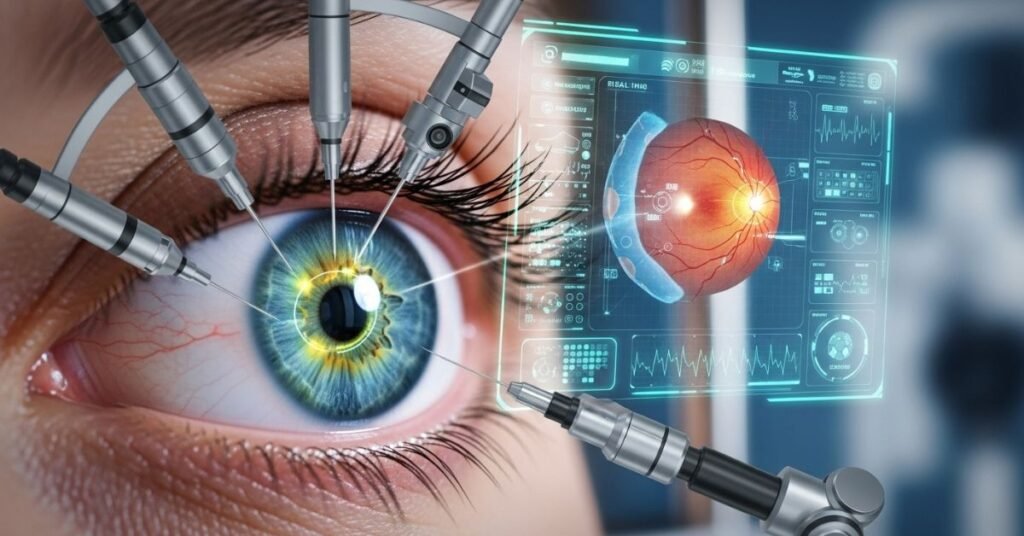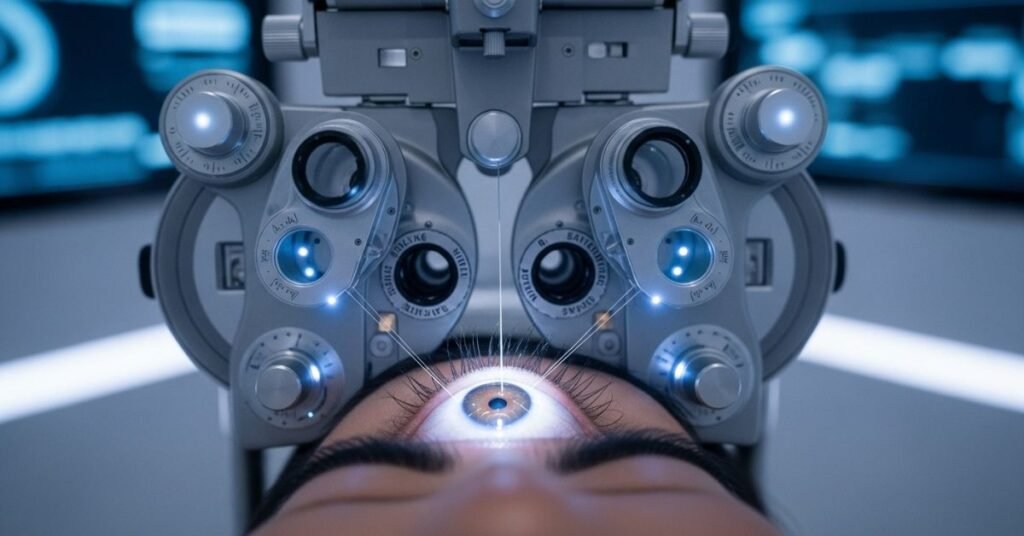Contents
- 1 Introduction
- 2 The Role of Precision in Modern Eye Care
- 3 DGH A’s History and Evolution
- 4 Key Technologies Developed by DGH A
- 5 How DGH A Improves Diagnosis and Treatment
- 6 Benefits of DGH A for Patients
- 7 Benefits of DGH A for Eye Care Professionals
- 8 The Future of Eye Care with DGH A
- 9 Frequently Asked Questions (FAQs)
- 10 Final Thoughts
Introduction
The world of eye care is rapidly changing, with advanced tools reshaping how doctors diagnose and treat vision-related issues. Among these innovations, DGH A stands out as a leader in precision technology. Known for its highly accurate diagnostic instruments, DGH A is helping eye specialists provide better care, faster results, and more reliable treatments.
For patients, this means earlier detection of problems and tailored solutions that preserve vision. For doctors, it means dependable tools that reduce guesswork and save time. With rising cases of eye conditions like glaucoma, cataracts, and refractive errors worldwide, precision technology is no longer optional—it’s essential.
In this article, we’ll explore how DGH A is transforming eye care through cutting-edge devices, its role in improving accuracy, the benefits for both patients and professionals, and what the future may hold for this growing field. Whether you’re a medical practitioner, researcher, or simply someone curious about eye health, this deep dive into DGH A will give you valuable insights into why it matters today more than ever.
The Role of Precision in Modern Eye Care
Precision is the foundation of effective eye care. The human eye is an incredibly delicate organ, and even a small error in measurement or diagnosis can have major consequences. This is why eye doctors rely heavily on tools that can provide exact data. DGH A has built its reputation on delivering instruments that offer unmatched precision in eye measurements.
Traditional diagnostic methods often involved manual calculations, which were prone to human error. For example, measuring corneal thickness, a key factor in detecting glaucoma, required great skill and experience. With DGH A’s devices, these measurements are now automated, fast, and more accurate than ever.
The ability to detect changes at microscopic levels means diseases can be caught earlier, sometimes even before patients notice symptoms. Early intervention is the best way to prevent vision loss, and precision tools make that possible.
For surgeons, precision also ensures better outcomes. When planning cataract or refractive surgery, exact corneal and lens measurements are critical. DGH A’s technology helps create surgical plans that are customized for each patient, minimizing risks and maximizing success rates.
DGH A’s History and Evolution
Understanding the impact of DGH A requires looking at its history. The company has long been a trusted name in ophthalmology, focusing on the development of diagnostic ultrasound and pachymetry devices. From its early days, DGH A emphasized reliability and innovation, creating solutions that filled gaps in the eye care industry.
In the past, eye doctors had limited access to tools that could provide quick and accurate results. DGH A entered the market with devices that not only simplified the diagnostic process but also delivered results that doctors could trust. Over time, these products became standard in clinics and hospitals worldwide.
The expansion of the business is indicative of its dedication to R&D. As technology advanced, DGH A incorporated digital imaging, portable designs, and user-friendly interfaces into its devices. This evolution made it easier for doctors to integrate advanced diagnostics into everyday practice without needing extensive training.
Today, DGH A stands as a symbol of precision technology in eye care, with a product line that continues to expand in both scope and capability. It has gone from being a niche manufacturer to a global leader trusted by eye specialists in many countries.
You Might Also Like: Lyncconfd.com
Key Technologies Developed by DGH A

One of the reasons DGH A has become a leader in eye care is its wide range of innovative technologies. Each product is designed to solve a specific problem while ensuring the highest level of accuracy. Some of the standout technologies include:
1. Ultrasound Pachymetry
This is one of DGH A’s core strengths. Pachymeters measure corneal thickness, which is vital in diagnosing and managing glaucoma. DGH A pachymeters are known for their portability, accuracy, and ease of use, making them a go-to choice for eye doctors.
2. Ultrasound Biometry
Biometry is essential for planning cataract surgeries. DGH A’s ultrasound biometers deliver exact axial length measurements of the eye, which are necessary for selecting the right intraocular lens. This lowers the surgical margin of error.
3. Anterior Segment Imaging
With advanced ultrasound technology, DGH A devices can capture images of the eye’s anterior segment. This helps in diagnosing structural abnormalities and planning corrective procedures.
4. User-Friendly Digital Interfaces
Modern DGH A devices come equipped with digital touchscreens and software that make data collection seamless. Doctors can easily save, share, and compare patient records over time, improving continuity of care.
Each of these technologies has changed how ophthalmologists diagnose and treat patients, making precision a standard rather than a luxury.
How DGH A Improves Diagnosis and Treatment
Accurate diagnosis is the cornerstone of effective treatment. Without it, doctors may choose the wrong approach, leading to unnecessary procedures or worsening conditions. DGH A devices reduce these risks by giving doctors dependable data.
Take glaucoma, for instance. One of the main diagnostic factors is intraocular pressure (IOP). However, corneal thickness plays a key role in interpreting IOP results correctly. A thinner cornea can make IOP appear lower than it actually is, while a thicker cornea can make it appear higher. DGH A pachymeters provide exact corneal thickness measurements, helping doctors avoid misdiagnosis.
In cataract surgery, accurate axial length measurements ensure the implanted lens fits the patient perfectly. Even a small miscalculation can leave patients with blurry vision post-surgery. DGH A’s ultrasound biometers minimize this risk, giving patients better surgical outcomes and faster recovery.
For patients with corneal diseases, imaging the anterior segment is vital. By providing clear images of corneal structures, DGH A devices allow doctors to design treatment strategies tailored to each case. This leads to better control of diseases like keratoconus and corneal dystrophies.
In short, DGH A technology not only improves accuracy but also builds confidence for both doctors and patients in the treatment process.
Benefits of DGH A for Patients
From a patient’s perspective, DGH A’s precision technology translates into several benefits that go beyond just accurate results.
First, it reduces uncertainty. Patients often feel anxious when facing eye problems, especially when surgery is involved. Knowing that their doctor is using state-of-the-art diagnostic tools reassures them that they’re getting the best possible care.
Second, it ensures early detection. Many eye diseases progress silently and only show symptoms when significant damage has occurred. Tools like pachymeters and biometers catch issues earlier, giving patients more treatment options and a better chance of preserving vision.
Third, it shortens procedure times. Because DGH A devices provide instant, reliable data, patients spend less time in the clinic. Quick and efficient measurements mean less waiting and smoother appointments.
Lastly, it improves surgical outcomes. Patients undergoing cataract or refractive surgery are more likely to enjoy sharper vision and fewer complications when precise measurements guide the procedure.
These benefits collectively create a more positive experience for patients, where technology directly enhances their quality of life.
You Might Also Like: Doge Software Licenses Audit HUD
Benefits of DGH A for Eye Care Professionals
For ophthalmologists, optometrists, and surgeons, DGH A technology offers clear advantages that make clinical practice more effective.
One of the most important benefits is reliability. With DGH A devices, doctors know they’re working with trustworthy data, reducing second-guessing and boosting confidence in treatment decisions.
Another benefit is efficiency. Modern eye clinics face high patient loads, and time is always limited. DGH A’s fast and easy-to-use devices allow doctors to see more patients without compromising quality of care.
Additionally, the portability of many DGH A devices means they can be used in different clinical settings. Whether in a large hospital or a smaller private practice, doctors can bring precision technology directly to where it’s needed.
Training is also simplified. Even new employees can easily learn how to use DGH A equipment because to its user-friendly interfaces, which guarantees efficient clinic operations.
For surgeons, the biggest advantage is accuracy in surgical planning. With better data, surgeries become safer, recovery is quicker, and patient satisfaction increases.
Ultimately, DGH A tools help doctors provide care that is not only more precise but also more efficient and patient-centered.
The Future of Eye Care with DGH A

As medical technology continues to evolve, the role of companies like DGH A will only grow. The future of eye care will likely see even more integration of digital tools, artificial intelligence, and data-driven solutions. DGH A is already positioned to adapt and lead in this transformation.
One area of growth is telemedicine. With portable and digital-ready devices, DGH A can support remote eye exams, expanding access to quality care in underserved regions. Patients who live far from specialized clinics could benefit from accurate diagnostics closer to home.
Another trend is personalization. As data collection becomes more advanced, doctors will be able to design treatment plans that are even more tailored to individual patients. DGH A’s role in providing high-quality data will be central to this shift.
Integration with surgical robotics may also be on the horizon. Precision measurements from DGH A devices could be directly linked to surgical platforms, ensuring seamless transitions from diagnosis to treatment.
With a strong history of innovation and a focus on precision, DGH A is well-positioned to shape the next era of eye care, making treatments safer, more effective, and more widely accessible.
You Might Also Like: Chas6d
Frequently Asked Questions (FAQs)
1. What does DGH A specialize in?
DGH A specializes in precision diagnostic instruments for eye care, including pachymeters, biometers, and anterior segment imaging devices.
2. How does DGH A technology help in glaucoma management?
By providing accurate corneal thickness measurements, DGH A devices help doctors correctly interpret intraocular pressure, which is vital in diagnosing and monitoring glaucoma.
3. Are DGH A devices useful for cataract surgery?
Yes. DGH A biometers deliver precise axial length measurements, ensuring the correct lens is chosen for cataract surgery, which improves surgical outcomes.
4. Can patients benefit directly from DGH A technology?
Absolutely. Patients benefit from early disease detection, reduced clinic times, improved surgical planning, and greater peace of mind.
5. Are DGH A devices easy to use for new practitioners?
Yes. Most DGH A devices feature user-friendly digital interfaces, making them accessible even for practitioners with limited experience.
6. What makes DGH A stand out from competitors?
Its long-standing reputation for accuracy, portability, and reliability has made DGH A a trusted choice for eye care professionals worldwide.
7. Is DGH A technology future-ready?
Yes. With digital integration and potential applications in telemedicine and surgical robotics, DGH A is ready to meet the needs of future eye care.
Final Thoughts
Eye care is an area where precision truly matters. The slightest inaccuracy can mean the difference between clear vision and lasting impairment. DGH A has become a trusted name by consistently delivering technologies that raise the standard of care. For patients, this means better outcomes. For professionals, it means reliable tools that support their expertise.
As the demand for quality eye care continues to rise, especially in aging populations, technologies like those from DGH A will play an even greater role. By blending innovation with dependability, DGH A is not just keeping up with the future of eye care—it is helping shape it.



